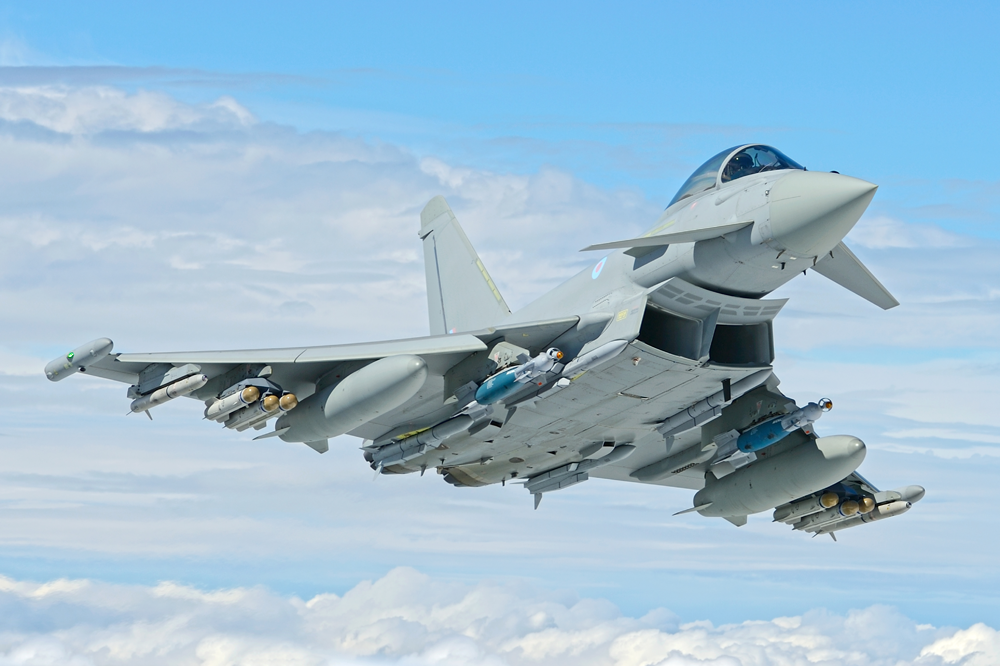On July 4, British Eurofighter Typhoons stationed in Estonia were scrambled to intercept the Russian military aircraft.
The British Royal Air Force (RAF) took to Twitter to announce that their Eurofighter Typhoons were mobilized to intercept a Russian Air Force Tu-214 aircraft, which was being escorted by two Su-30M Flanker jets over the Baltic Sea.
In addition, the RAF also shared images of the Tu-214 aircraft as it flew through international airspace, moving southward and then changing its direction to head north again, between mainland Russia and the Kaliningrad Oblast.
Since March, the Typhoon aircraft belonging to the number 1 (Fighter) Squadron based at RAF Lossiemouth have been deployed to Amari Air Base.
This deployment is a significant contribution by the UK to NATO, allowing the Typhoons to operate effectively from the Estonian base and play a leading role in enhancing regional security.
RAF Typhoons in Estonia scrambled today to intercept a Russian Air Force Tu-214 flying in international airspace under the control of @NATO allies as it transited south and then north again with 2x Su-30M Flanker Hs between mainland Russia and the Kaliningrad Oblast.
# WeareNATO pic.twitter.com/cX11nDrjGG
— Royal Air Force (@RoyalAirForce) July 4, 2023
On June 25, the Ministry of Defense revealed that RAF Typhoon fighters, fulfilling their role as Quick Reaction Alert (QRA) aircraft for the NATO Baltic Air Policing mission in Estonia, have been activated 21 times in the past 21 days to respond to Russian aircraft approaching the region.
The Typhoon Squadron receives support from approximately 100 RAF personnel deployed as part of the 140 Expeditionary Air Wing (EAW). This team plays a crucial role in facilitating and enabling the flying activities of the squadron.
In addition to the RAF’s involvement, the Portuguese and Romanian Air Forces also participate in these missions, with their respective aircraft based in Lithuania.
The UK government mentioned that the Eurofighter Typhoons are launched to closely monitor Russian aircraft that fail to establish communication with air traffic agencies.

This lack of communication poses a potential risk to flight safety. Therefore, the Typhoons are deployed to ensure that these unidentified aircraft are closely tracked, and their intentions are assessed to maintain the safety and security of the airspace.
During their deployment to Estonia, the RAF has actively engaged in various major exercises alongside NATO allies.
One notable exercise is Exercise Air Defender, which stands out as the largest NATO Air Deployment drill since the conclusion of the Cold War. This exercise involved the participation of over 250 aircraft and 10,000 personnel from 25 different nations.
Russian Military Aircraft Detected By NORAD
Meanwhile, the presence of Russian military aircraft was documented in the airspace near Alaska. On July 4, the US military revealed that four Russian military jets were tracked flying in airspace near Alaska, which falls under the monitoring jurisdiction of the US for national security purposes.
The incident occurred on July 3 in the Alaska Air Defense Identification Zone (ADIZ) and was reported by the North American Aerospace Defense Command (NORAD).
The area is classified as international airspace and does not fall under the jurisdiction of the United States or Canada. However, NORAD monitors this airspace for national security purposes.
NORAD officials stated that the presence of Russian aircraft in the zone is a regular occurrence and is not perceived as a threat.
This incident occurred against the backdrop of escalating tensions between Russia and the US following the Russian invasion of Ukraine in February 2022.
The US and other allies have provided financial aid and weapons to support Ukraine’s efforts to repel Russian forces.
The NORAD statement, released on Twitter, confirmed the detection and tracking of four Russian military aircraft operating in the Alaska ADIZ on July 3, 2023.
— North American Aerospace Defense Command (@NORADCommand) July 4, 2023
It explained that the Russian aircraft remained within international airspace and did not enter the sovereign airspace of the US or Canada.
The information does not provide the exact details regarding when and where the four Russian jets were observed and tracked on July 3.
But, the Russian Ministry of Defense disclosed that Two Tu-95MS strategic missile carriers carried out a scheduled flight near the west coast of Alaska.
The duration of the flight exceeded 13 hours, during which the crews of the Tu-95MS aircraft engaged in aerial refueling exercises.
That being said, it is unclear if the number of such incidents has changed since the start of the Russian-Ukrainian conflict.
However, a previous statement from NORAD mentioned that Russia has been conducting out-of-area long-range aviation flights since 2007. These flights have led to an average of approximately six to seven aerial intercepts annually.
NORAD maintains a close collaboration with the Pentagon’s Northern Command, which typically provides the interceptor aircraft for monitoring Russian flights.
Canadian jets have also been involved in the past as part of this cooperative effort. This partnership ensures effective coordination and response capabilities to address and monitor Russian aircraft activities in the region.
- Contact the author at ashishmichel(at)gmail.)com
- Follow EurAsian Times on Google News




